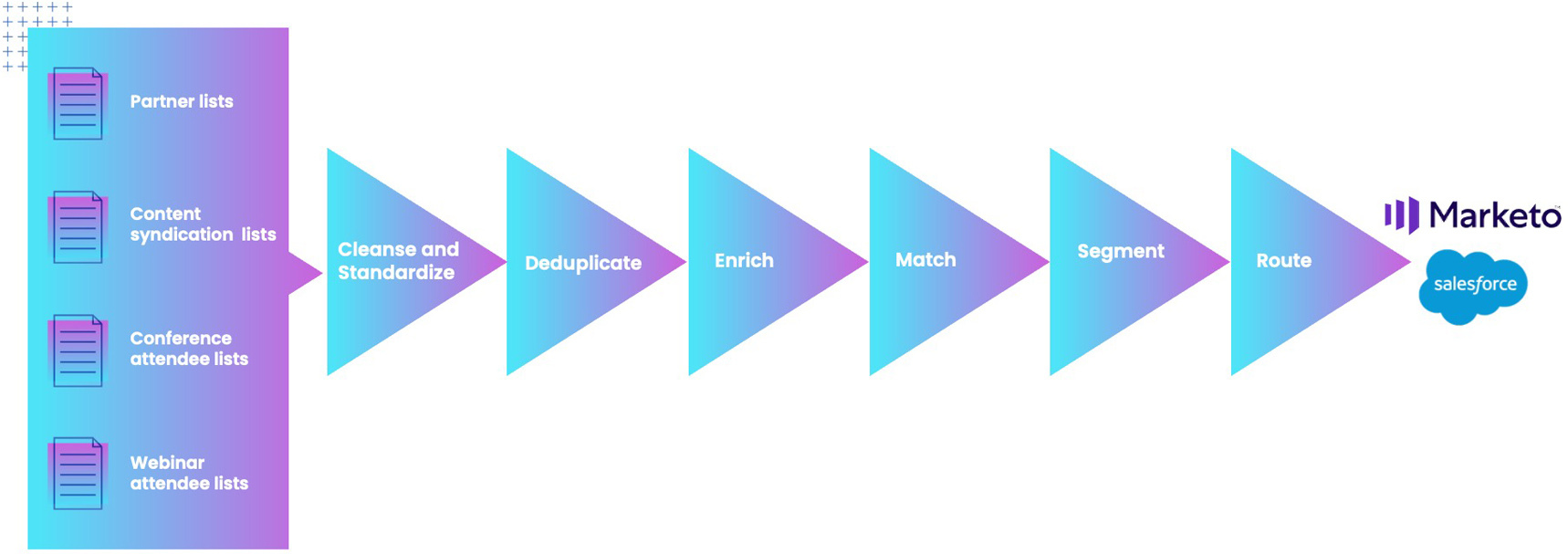
How to solve data onboarding challenges
Sales and marketing technologies have come a long way in a short time, but they still have miles to go before teams are freed from the manual, error-prone processes that plague them. Of these, data onboarding has been one of the most difficult to solve through automation.
While list loading is probably the most commonly conceived use case, data onboarding comprises a wide range of other sources and activities that, not coincidentally, also contribute to its complexity. Things get even more complicated when multiple groups are onboarding lead data, with no consistent standards for list structure and field values.
Further exacerbating the problem is the typical staffing assignments for these tasks, which usually fall into junior, inexperienced hands—hands that are prone to skipping essential steps like standardization/normalization and deduplication. The poor data quality that results often has a ripple effect that negatively impacts everything downstream, from lead scoring and routing to segmentation.
Expensive–yet ineffective–solutions to data onboarding
In response, many companies resort to hiring expensive data onboarding consultancies that charge upwards of $50,000 to $100,000 a year or more. However, these investments often yield no substantial improvements, no matter how well they document their processes. The problem lies in the sheer scale of today’s data streams: as the volume and speed of data increase, no amount of manual procedures can keep pace.
With automation being the obvious answer, it’s fair to ask why sales and marketing automation platforms have yet to successfully solve it. The answer lies in the complexity of the process. A picture is worth a thousand words: the diagram below demonstrates how an end-to-end onboarding process can involve multiple sources and steps.
The role of automation
To streamline these tasks, the typical tech stack employs several point marketing and sales solutions. This setup complicates automation, which at its basic level requires a highly flexible platform with extensive connectivity to different systems and third-party services. Generally, this leaves you with two options:
- Develop your own custom solution using a collection of middleware technologies like data integration and business process automation.
- Use a comprehensive, self-service RevOps automation platform like Openprise.
While developing your own solution might sound appealing, the costs are often prohibitive. Let’s do a quick breakdown of the costs.
A cost-benefit analysis of data onboarding automation
Begin with the technology. Developing your own middleware often requires at least $250,000 in technology investments and another $250,000 in consulting services, and typically requires a minimum of nine months to complete. Now let’s add the personnel costs. While most businesses spend far more than four hours a week on manual data onboarding, we’ll start there for our calculations. Using $75 as the hourly labor cost, although it’s often far more, the cost to manually onboard data in-house can easily exceed $15,000 a year. That doesn’t include the IT help to support it.
In contrast, the Openprise RevOps Data Automation Cloud starts at a few thousand dollars a month, and automates not only data onboarding but other processes as well. With no initial technology outlays or other hidden costs, the savings add up quickly. And that’s not even factoring in the boost to morale and productivity you’ll gain from shifting employees to more rewarding work—or the considerable advantages of better data quality and faster lead times.
As our simple back-of-the-envelope calculation shows, an automated RevOps solution can easily reduce your data onboarding costs by 75%. If the clear ROI value isn’t enough to sway you, the additional revenue from faster, higher quality leads might. At the least, you owe it to yourself and your team to explore it further. As a next step, check out our white paper, Data onboarding: a step-by-step guide to automated data importing in sales and marketing solutions.
Recommended resources
















Leave a comment